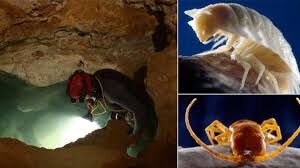33 living creatures were discovered in a cave which was sealed off for 5 million years
Being closed off from the world for so long caused fresh air to become completely nonexistent in the cave, rendering the air inside toxic and...

Being closed off from the world for so long caused fresh air to become completely nonexistent in the cave, rendering the air inside toxic and...
Being closed off from the world for so long caused fresh air to become completely nonexistent in the cave, rendering the air inside toxic and oppressively humid. However, these conditions not only allowed for incredible life to be formed, but to thrive.
After 5 million years of total isolation from the world, what do you think you’d find inside a totally sealed off cave? Dinosaurs? Prehistoric bugs? Evidence of alien life? No one knew until Dr. Christian Lascu finally opened up Movile cave in Romania.
Living in complete darkness, almost every creature living in Movile cave has no vision whatsoever and lacks any kind of color pigments. Without the ability to see, the organisms developed extremely long antennae, limbs, and other bodily features to easily feel their way around the inside of the cave. No creature really needs eyesight when it lives in perpetual darkness, does it? The location also is home to a unique ecosystem that utilizes the toxic gases in the cave. In order for the many types of bacteria to eat, they have to use a process called chemosynthesis. Similar to the photosynthesis process that plants use on the surface, this method uses toxic gas instead of sunlight. Chemosynthesis allows organisms to create energy via chemical reactions to help generate food. Worms, shrimp, and other small creatures use the bacteria for food, while the scorpions, spiders, and other invertebrates feed on the smaller animals. This creates a perfect circle of life that allows everything inside the cave to continue living and be totally self-sufficient.
On dry land, Movile cave is the only
ecosystem of its kind. But down in the depths of the ocean, there are
similar areas that survive near hydrothermal vents that produce much of
the same kind of life.
After 30 years of being open to scientists, Movile cave has potential
to provide a lot of new information about the evolutionary process, but
there is still a lot to be researched from this area of the world. Many
experts still do not know how the animals even came to be a part of the
cave, despite some likely explanations.
“It’s very likely that the bacteria have been there a lot longer than
five million years, but that the insects became trapped there around
that time,” J. Colin Murrell, a microbiologist from the University of East Anglia, said.
“They could have simply fallen in and become trapped when the limestone
cast dropped, sealing the cave until it was discovered again in 1986.”
There is still plenty to be explored and discovered in Movile cave,
and science will likely be researching this incredible location for many
years to come.






